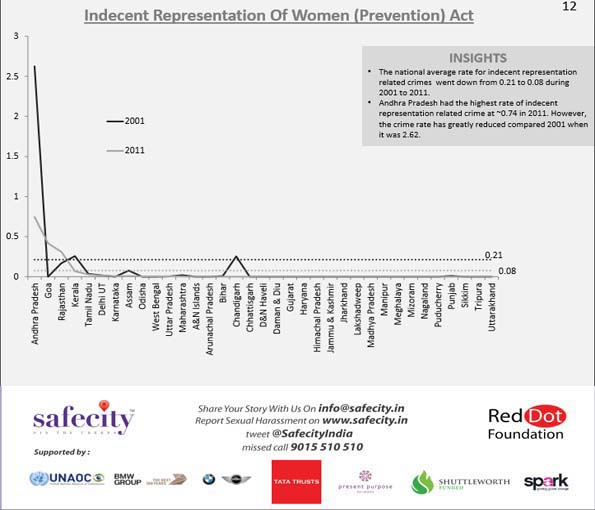Indecent Representation of Women

Shriya Sharma is a third year law student, brilliant at academics and exceptional at extra curricular. She is a strong supporter of women empowerment.
Indecent Representation of Women
“India has been ranked as the worst G-20 country, to be a woman in – Trust Law, Thomson Reuters.
One bride is murdered every hour for dowry as of 2010 –National Crime Records Bureau
Almost 45% of Indian girls are married before the age of 18 – International Center for Research on Women.
One in Five women, in India, die during pregnancy or child birth – United Nations.
Over the past decade, over 50 million Indian girls are missing.”
These statistics show the reality of condition of women in India and even though women can be victims of any of the general crimes such as “murder”, “cheating”, “robbery” etc. the crimes that are specifically targeted against women are characterized as ‘Crimes against women’. These crimes are prevalent throughout the country.
These “crimes against women” has been broadly classified into two categories:
- The crimes under the Indian Penal Code
- The crimes under the Special and Local laws.
The crimes under the Special and local laws are gender specific laws, such as –
- The Dowry Prohibition Act, 1961
- The Indecent Representation of Women (Prohibition) Act, 1986
- The Commission of Sati Prevention Act, 1987
- The Protection of women from domestic Violence Act, 2005
- The Immoral Traffic (Prevention) Act, 1956
In totality around 3,37,922 cases of crime against women were reported in the country during the year 2014 as compared to 3,09,546 that were recorded in the year 2013. This indicates that the number of crimes increased in a matter of just one year itself.
The crime against women of indecent representation is regulated under the “INDECENT REPRESENTATION OF WOMEN (PROHIBITION) ACT, 1986.”
Section 2(c) of this act defines ‘indecent representation’ to mean “the depiction in any manner of the figure of a woman, her form or body or any part thereof in such a way as to have the effect of being indecent, or derogatory to, or denigrating women, or is likely to deprave, corrupt or injure the public morality or morals.”
The bill of this act was introduced in the Rajya Sabha as a response to a women’s movement for a legislative action against the derogatory depiction of women in India.
The act aimed to regulate the representation and portrayal of women in mainstream media in particular print media. It aimed to bring into force to ensure that the portrayal of women in media, by means of advertisements, writings, publications and illustrations was not such that could be termed “indecent”. The time period in which it was enacted. 1986, which continues to be in force, focused primarily on print media and advertising.
With the introduction of the internet, technological advancement and the development of electronic media, there has been revolutionary change in the field of mass media and communication. Owing to the same, a need was felt to amend the 1986 act to broaden its scope and bring within its ambit all other forms of media and publication introduced with the technological revolution. Thus. the Indecent Representation of Women (Prohibition) Bill, 2012 was introduced in the Rajya Sabha.
Under this proposed new bill the definition of indecent representation has been broadened to go as follows – “Indecent representation” means (i) publication or distribution in any manner, of any material depicting women as a sexual object or which is lascivious or appeals to the prurient interests; or (ii) depiction, publication or distribution in any manner, of the figure of a woman, her form or body or any part thereof in such a way as to have the effect of being indecent or derogatory to or denigrating women or which is likely to deprave, corrupt or injure the public morality or morals.”
Apart from broadening the scope of the law, the pending bill enactment also introduces stricter penal terms by way of increasing the quantum of punishment as well as the fine, especially for the repeat offenders.
Many cases have been filed under the 1986 act, with regard to this crime like for instance : Ajay Goswami Vs. Union of India (Uoi) and ors.; Aveek Sarkar Vs. State of West Bengal etc.
The graph below shows the rate of this crime across various states of the country and over the decade of 2001-2011.
As per the National Crime Records Bureau (NCRB) data which is available up to 2014, a total of 895, 453, 141, 362 and 47 cases were reported in the country under Indecent Representation of Women (Prohibition) Act, 1986 during last five-year i.e. 2010, 2011,2012, 2013 and 2014 respectively which shows a mixed trend.
A decline of 87.0% was noticed in this crime head during the year 2014 as compared to the previous year (362 cases). Rajasthan reported maximum cases (18 cases out of 47 cases) with crime rate of 0.1.
The crime rate for this crime has though considerably reduced, but still its existence from our society has not yet been eliminated and as stated above due to increased internet usage and advent of social media the risk has become manifold. Thus, we have to all work towards not indulging in publication/reading/writing/watching any kind of work that tends to be “indecent” and uphold our moral obligations.
Opinions are of the writer.


